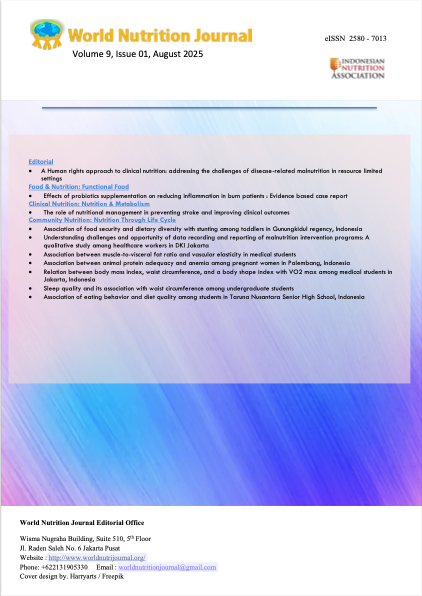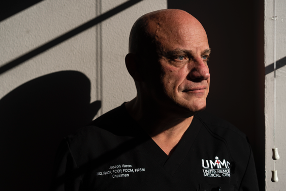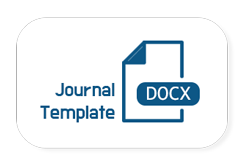Association between muscle-to-visceral fat ratio and vascular elasticity in medical students
Abstract
Background: Medical students often adopt lifestyles that contribute to decreased muscle mass and increased visceral fat accumulation, which can negatively impact vascular elasticity, a biomarker for the early detection of cardiovascular disease. Objective: This study aims to evaluate the association between the muscle mass to visceral fat ratio and vascular elasticity in medical students at Universitas Pembangunan Nasional Veteran Jakarta (UPNVJ). Methods: A cross-sectional design was conducted from November 2023 to January 2024 at UPNVJ. The sample consisted of 51 subjects who met the research criteria. The muscle-to-visceral fat (MVF) ratio was measured using Bioelectrical Impedance Analysis (BIA), while vascular elasticity was assessed using the Accelerated Photo plethysmograph Analyzer SA-3000P. Results: The results revealed that 68.6% of the subjects had the lowest MVF ratio and 54.9% exhibited sub-optimal vascular elasticity. No differences were found in age, gender, physical activity, or eating habits between the vascular elasticity groups (p > 0.05). The Chi-square test revealed a significant association between the MVF ratio and vascular elasticity (p = 0.009; OR = 6.545; 95% CI = 1.7–24.9). Conclusion: Students with the lowest MVF ratio were found to be 6.54 times more likely to have sub-optimal vascular elasticity, compared to those with low and high MVF ratios, indicating an increased risk of cardiovascular disease. These findings underscore the importance of early preventive intervention aimed at optimizing body composition through targeted wellness programs. The implementation of nutritional education and structured physical activity initiatives, particularly in young adults, may play a critical role in reducing the risk of cardiovascular disease.Downloads
References
Coronado F, Melvin SC, Bell RA, Zhao G. Global Responses to Prevent, Manage, and Control Cardiovascular Diseases. Prev Chronic Dis. 2022;19:1–6.
Wang J, Tan GJ, Han LN, Bai YY, He M, Liu H Bin. Novel biomarkers for cardiovascular risk prediction. Journal of Geriatric Cardiology. 2017;14(2):135–50.
Wilkinson IB, Maki-Petaja KM, Mitchell GF. Uses of Arterial Stiffness in Clinical Practice. Arterioscler Thromb Vasc Biol. 2020;40(5):1063–7.
Aminuddin A, Noor Hashim MF, Mohd Zaberi NAS, Zheng Wei L, Ching Chu B, Jamaludin NA, et al. The Association Between Arterial Stiffness and Muscle Indices Among Healthy Subjects and Subjects With Cardiovascular Risk Factors: An Evidence-Based Review. Front Physiol. 2021;12(November).
Kemenkes. Hasil Utama RISKESDAS 2018 [Internet]. Jakarta; 2018 [cited 2020 Jun 28]. Available from: https://drive.google.com/file/d/1MRXC4lMDera5949ezbbHj7UCUj5_EQmY/view
Kim TN, Park MS, Ryu JY, Choi HY, Hong HC, Yoo HJ, et al. Impact of visceral fat on skeletal muscle mass and vice versa in a prospective cohort study: The Korean Sarcopenic Obesity Study (KSOS). PLoS One. 2014;9(12):1–13.
Zhang S, Huang Y, Li J, Zhang M, Wang X, Wang X, et al. The visceral fat area to skeletal muscle mass ratio (VSR) is signficantly associated with the risk of cardiometabolic diseases in a young and middle-aged Chinese natural population: a cross-sectional study. Res Sq [Internet]. 2022;1–12. Available from: https://doi.org/10.21203/rs.3.rs-1285371/v1
Büschges J, Schaffrath Rosario A, Schienkiewitz A, Königstein K, Sarganas G, Schmidt-Trucksäss A, et al. Vascular aging in the young: New carotid stiffness centiles and association with general and abdominal obesity – The KIGGS cohort. Atherosclerosis. 2022;355(May):60–7.
Powell-Wiley TM, Poirier P, Burke LE, Després JP, Gordon-Larsen P, Lavie CJ, et al. Obesity and Cardiovascular Disease A Scientific Statement From the American Heart Association. Circulation. 2021;143(21):E984–1010.
Park HE, Chung GE, Lee H, Kim MJ, Choi SY, Lee W, et al. Significance of Low Muscle Mass on Arterial Stiffness as Measured by Cardio-Ankle Vascular Index. Front Cardiovasc Med. 2022;9(June):1–8.
Xu J, Pan X, Liang H, Lin Y, Hong Y, Si Q, et al. Association between skeletal muscle mass to visceral fat area ratio and arterial stiffness in Chinese patients with type 2 diabetes mellitus. BMC Cardiovasc Disord. 2018;18(1):1–8.
Ramírez-Vélez R, Garcia-Hermoso A, Prieto-Benavides DH, Correa-Bautista JE, Quino-Ávila AC, Rubio-Barreto CM, et al. Muscle mass to visceral fat ratio is an important predictor of the metabolic syndrome in college students. British Journal of Nutrition. 2019;121(3):330–9.
Simanjuntak K, Saleh AY, Purwani LE. Pemberdayaan Asupan Rendah Kalori dan Aktivitas Fisik Mahasiswa Obesitas FK UPN Veteran Jakarta. Abdi: Jurnal Pengabdian dan Pemberdayaan Masyarakat. 2020;2(2):141–7.
Shafiee A, Nakhaee Z, Bahri RA, Amini MJ, Salehi A, Jafarabady K, et al. Global prevalence of obesity and overweight among medical students: a systematic review and meta-analysis. BMC Public Health. 2024;24(1):1–9.
Liu D, Zhong J, Wen W, Ruan Y, Zhang Z, Sun J, et al. Relationship between skeletal muscle mass to visceral fat area ratio and cardiovascular risk in type 2 diabetes. Diabetes, Metabolic Syndrome and Obesity. 2021;14(June):3733–42.
Li Q, Spalding KL. The regulation of adipocyte growth in white adipose tissue. Front Cell Dev Biol. 2022;10(November):1–13.
Mahriani Y, Indriyanti R, Musnamirwan IA, Setiawan AS. A cross-sectional study on dietary assessment, oral hygiene behavior, and oral health status of adolescent girls. Front Nutr. 2022;9(October):1–9.
van den Helder J, Verreijen AM, van Dronkelaar C, Memelink RG, Engberink MF, Engelbert RHH, et al. Bio-Electrical Impedance Analysis: A Valid Assessment Tool for Diagnosis of Low Appendicular Lean Mass in Older Adults? Front Nutr. 2022;9(June):1–9.
Murakami T, Asai K, Kadono Y, Nishida T, Nakamura H, Kishima H. Assessment of arterial stiffness index calculated from accelerated photoplethysmography. Artery Res. 2019;25(1–2):37–40.
Lin X, Liu H. A study on the effects of health behavior and sports participation on female college students’ body mass index and healthy promoting lifestyle. Front Public Health. 2023;10.
Chitme HR, Alward N, Al Ward N, Rashid Alkaabi T, Rashid Alshehi R. Body Fat Distribution among College Students. EC Pharmacol Toxicol [Internet]. 2018;6(June):445–54. Available from: https://ecronicon.net/assets/ecpt/pdf/ECPT-06-00183
Rabia R, Oktarina M, Hendrawan T, Rijal R. Perbandingan Massa Otot Skeletal Antara Mahasiswa Fisioterapi Dengan Masked Obesity Dan Normal. Jurnal Ilmu Kedokteran dan Kesehatan. 2023;10(4):1799–804.
Fernberg U. Arterial stiffness and risk factors for cardiovascular disease in young adults. 2019. 98 p.
Agbaje AO. Arterial stiffness precedes hypertension and metabolic risks in youth: a review. J Hypertens. 2022;40(10):1887–96.
Uejima T, Dunstan FD, Arbustini E, Łoboz-Grudzień K, Hughes AD, Carerj S, et al. Age-specific reference values for carotid arterial stiffness estimated by ultrasonic wall tracking. J Hum Hypertens. 2020;34(3):214–22.
Lu Y, Kiechl SJ, Wang J, Xu Q, Kiechl S, Pechlaner R, et al. Global distributions of age- and sex-related arterial stiffness: systematic review and meta-analysis of 167 studies with 509,743 participants. EBioMedicine. 2023;92:1–15.
;6(June):445–54. Available from: https://ecronicon.net/assets/ecpt/pdf/ECPT-06-00183
Rabia R, Oktarina M, Hendrawan T, Rijal R. Perbandingan Massa Otot Skeletal Antara Mahasiswa Fisioterapi Dengan Masked Obesity Dan Normal. Jurnal Ilmu Kedokteran dan Kesehatan. 2023;10(4):1799–804.
Fernberg U. Arterial stiffness and risk factors for cardiovascular disease in young adults. 2019. 98 p.
Agbaje AO. Arterial stiffness precedes hypertension and metabolic risks in youth: a review. J Hypertens. 2022;40(10):1887–96.
Uejima T, Dunstan FD, Arbustini E, Łoboz-Grudzień K, Hughes AD, Carerj S, et al. Age-specific reference values for carotid arterial stiffness estimated by ultrasonic wall tracking. J Hum Hypertens. 2020;34(3):214–22.
Lu Y, Kiechl SJ, Wang J, Xu Q, Kiechl S, Pechlaner R, et al. Global distributions of age- and sex-related arterial stiffness: systematic review and meta-analysis of 167 studies with 509,743 participants. EBioMedicine. 2023;92:1–15.
Makkiyah FA, Harfiani E, Anisah A. Pengaruh Jenis Kelamin dalam Variasi Indeks Prestasi Kumulatif Mahasiswa Kedokteran di Universitas Pembangunan Nasional Veteran Jakarta. Jurnal Profesi Medika : Jurnal Kedokteran dan Kesehatan. 2019;13(1):35–9.
Ogola BO, Zimmerman MA, Clark GL, Abshire CM, Gentry KM, Miller KS, et al. Sex differences in cardiovascular and cerebrovascular physiology, disease, and signaling mechanisms: New insights into arterial stiffening: Does sex matter? Am J Physiol Heart Circ Physiol. 2018;315(5):H1073–87.
Safar ME, Regnault V, Lacolley P. Sex Differences in Arterial Stiffening and Central Pulse Pressure: Mechanistic Insights? J Am Coll Cardiol. 2020;75(8):881–3.
Saz-Lara A, Cavero-Redondo I, Álvarez-Bueno C, Notario-Pacheco B, Ruiz-Grao MC, Martínez-Vizcaíno V. The acute effect of exercise on arterial stiffness in healthy subjects: A meta-analysis. J Clin Med. 2021;10(2):1–14.
Park W, Park HY, Lim K, Park J. The role of habitual physical activity on arterial stiffness in elderly Individuals: a systematic review and meta-analysis. J Exerc Nutrition Biochem. 2017;21(4):16–21.
Leed A, Sheridan E, Baker B, Bamford S, Emmanouilidis E, Stewart F, et al. Dietary Intake and Arterial Stiffness in Children and Adolescents: A Systematic Review. Nutrients. 2023;15(9):1–29.
Liese AD, Couch SC, The NS, Crandell JL, Lawrence JM, Crume TL, et al. Association between diet quality indices and arterial stiffness in youth with type 1 diabetes: SEARCH for Diabetes in Youth Nutrition Ancillary Study. J Diabetes Complications. 2020;34(12):1–19.
Submitted
Copyright (c) 2025 Tsabita Ayudia, Nurfitri Bustamam, Yanti Harjono Hadiwiardjo, Diana Agustini Purwaningastuti

This work is licensed under a Creative Commons Attribution 4.0 International License.
World Nutrition Journal provides immediate open access to its content under the Creative Commons Attribution License (CC BY 4.0). This permits unrestricted use, distribution, and reproduction in any medium, provided the original work is properly cited.













